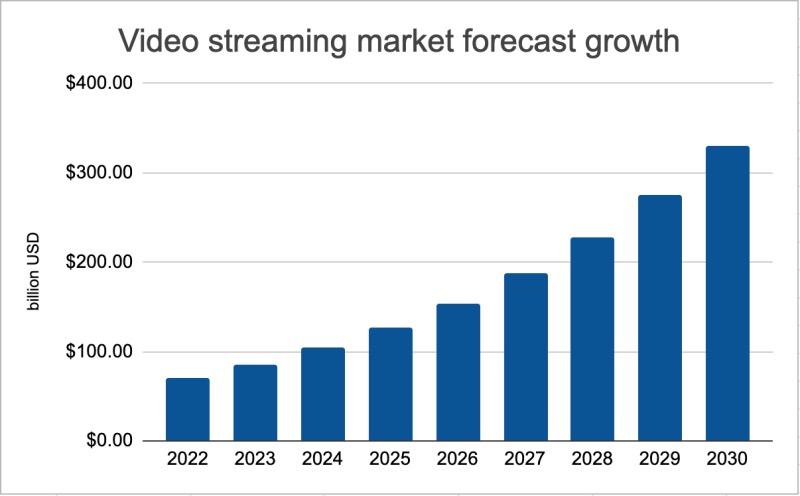Video Streaming App Development
– Everything You Need to Know in 2023

Video streaming apps – increasing popularity
Video streaming has become one of the most popular activities in the world. With the rise of high-speed internet and advanced mobile devices, people consume more video content than ever. The increased demand for online video content made businesses invest in video streaming app development to exploit this trend.
This article will provide a comprehensive guide on video streaming app development, including:
- Streaming market statistics
- Types of video streaming apps
- Monetization models
- Video streaming app development steps
- Video streaming app features
- Video streaming app development costs.
Video Streaming Market Statistics
The video streaming market is expected to experience significant growth in the upcoming years. The driving factors behind this growth are the increasing demand for video streaming services, advancements in internet technology, the rise in smartphone adoption, and the growing number of smart TV users.
According to a report by Grand View Research, the global video streaming market size was valued at USD 50.11 billion in 2020. The same agency says that the video streaming market size value in 2022 was USD 70.59 billion and is expected to reach USD 330.51 billion by 2030, at a compound annual growth rate (CAGR) of 21.3% from 2022 to 2030.
The graph below shows the forecasted growth of the global video streaming market from 2022 to 2030.
Types of Streaming Apps:
| Type of app | Description | Examples |
| Live Streaming Apps | Allow users to watch live videos in real-time, such as sports events, concerts, or news broadcasts. | Facebook Live, YouTube Live, and Twitch |
| Video-on-Demand Apps | Enable users to watch pre-recorded videos anytime, such as movies, TV shows, documentaries, and tutorials. | Netflix, Hulu, and Disney+ |
| Hybrid Streaming Apps | Offer live and pre-recorded videos, allowing users to choose between real-time and on-demand content. | Sling TV, Amazon Prime Video, and HBO Max |
OR
mail us at info@bianor.com
Monetization of Video Streaming
There are several ways to monetize video streaming apps:
- Subscription-based: Users pay a monthly or yearly fee to access premium content, as seen on Netflix or Hulu.
- Ad-based: The app shows ads during the video playback, generating revenue from advertisers like YouTube.
- Transactional: Users pay for each video they watch, as seen in Amazon Prime Video or iTunes.
- Freemium: Basic content is free, but users must pay for premium features like YouTube Premium.
Explore in more detail all video streaming monetization models >>>
Main Steps in Building a Video Streaming App/Platform
- Planning and Strategy
- The first step in building a video streaming app is to define the app’s concept and identify the target audience. You need to determine what kind of content your app will offer, whether live streaming or video-on-demand, and the specific niche your app will serve. Define features and monetization model and choose a suitable platform, such as iOS or Android.
- Design and Development
- Design the user interface and user experience. The user interface (UI) and user experience (UX) design are essential components of any app. You need to create a design that is visually appealing, intuitive, and reflects your brand identity. The next step is to develop the app’s backend and front end. The backend manages the content, user data, and interactions, while the front end is the user-facing part of the app users interact with.
- Testing
- After developing the app, test the app for functionality, performance, and security. It is crucial to test and debug it thoroughly. Testing helps identify and fix any bugs or issues affecting the user experience.
- Launch
- Once the app is tested and debugged, you can launch it in the app store and market it to your target audience. Marketing is critical in driving user acquisition and engagement, so you must develop a comprehensive marketing plan that includes social media, content marketing, and advertising.
- Maintenance and Updates
- Monitor the app’s performance and users’ feedback, and make updates as necessary.
Must-have Features of Video Streaming App
- High-quality Video Streaming: The app should offer high-quality video streaming optimized for different devices.
- Content Management System: The app should have a CMS to manage and organize the video content into categories.
- User Authentication: Users should be able to create accounts and log in to access personalized content and features.
- Search and Recommendations: The app should have a search function and offer personalized recommendations to users.
- Subscription and Payment Integration: the app should provide payment options via trusted online payment portals like PayPal and Stripe. Also, in-app purchasing with Apple, Google, Roku, and Amazon is a very well-welcomed option by the end users.
- Push Notifications: The app should send push notifications to users to notify them about new content and updates.
- Screen Casting and AirPlay: Users should be able to mirror their mobile devices to a larger screen, such as a smart TV.
- User Reviews and Ratings: Users should be able to rate and review the content.
Check out six key features that make a successful OTT platform >>>
Recommended Additional Features
- Social Media Integration: Users should be able to share content on social media platforms.
- Offline Download: Users should be able to download content to watch offline.
- Live Chat: The app should have a live chat feature to allow users to chat with other users or customer support.
- Multi-language and Multi-currency Support: The app should support different languages and currencies to cater to a global audience.
Costs for Developing a Video Streaming App
The cost of developing a video streaming app depends on several factors, such as the app’s complexity, features, platform, and location of the development team. On average, the cost of developing a video streaming app can range from $50,000 to $500,000+.
Read more details about the costs of building a video streaming platform >>>
Conclusion
In conclusion, video streaming apps have revolutionized how we consume media and entertainment content. With the rise of on-demand video streaming services, consumers can now access a vast array of content from the comfort of their homes, on any device, at any time. Developing a video streaming app requires a thorough understanding of the market, user behavior, and technological requirements. By following the guidelines and best practices outlined in this article, content owners can create successful video streaming apps that meet the needs of both their target audience and business goals. Whether you are a startup looking to disrupt the industry or an established player seeking to innovate and stay ahead of the competition, video streaming app development can offer many opportunities for growth and profitability.
OR
mail us at info@bianor.com
A brief glossary of terms
One will meet many terms and abbreviations during a video streaming app development project. To make it easier for you, here you can see some of the most common ones you will encounter.
- OTT
- Over-The-Top platforms stream video content over the internet at the request and to suit the requirements of the viewers.
- VOD
- Video on Demand is watching video content when we want and not when the content provider decides to broadcast it.
- AVOD
- Advertising-based Video on Demand is the closest to the traditional television one can get. It is free for the viewer, but the streaming is ad-supported, and advertisements interrupt the content flow.
- PPV
- Pay-Per-View, the user pays a one-time fee to watch the content; with the purchase, the user also gets either permanent access to the video or a limited number of replays.
- ABR
- Adaptive Bitrate Streaming adjusts the video quality based on network conditions to improve video streaming over HTTP networks.
- DRM
- Digital Rights management is a method of securing digital content to prevent unauthorized use and piracy.
- CMS
- Content Management System is a tool for user management, billing history, authentication and authorization, notifications, etc.
- CDN
- Content Delivery Network is a geographically distributed group of servers that work together to provide fast delivery of video content.
Check out a complete video streaming terminology list >>>
Bianor develops custom enterprise software solutions for clients such as AT&T, IBM, Duracell, and Legrand.
Our software engineering team specializes in-depth in video and image processing, data streaming, real-time broadcasting, encryption/decryption of video signals, analyses, recommendations, and data transfer.
Bianor holds NATO AQAP certification and is specialized in building mission-critical software solutions for the Defense Industry, implementing comprehensive projects for NATO and the EU Defense forces.
Video Streaming Lifecycle
Download Bianor’s white paper to learn more about the five most crucial components of video streaming lifecycle.

